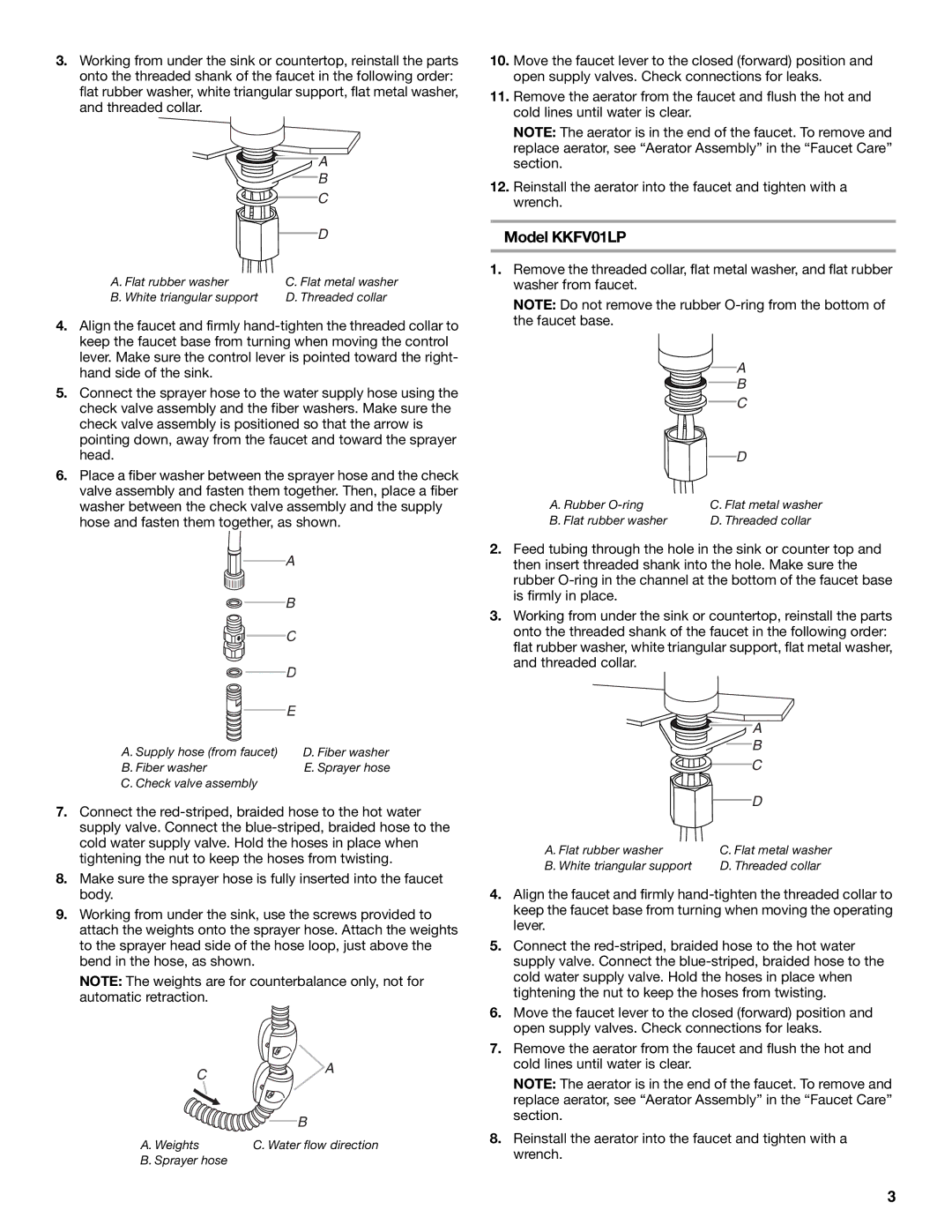
3.Working from under the sink or countertop, reinstall the parts onto the threaded shank of the faucet in the following order: flat rubber washer, white triangular support, flat metal washer, and threaded collar.
| A |
| B |
| C |
| D |
A. Flat rubber washer | C. Flat metal washer |
B. White triangular support | D. Threaded collar |
4.Align the faucet and firmly
5.Connect the sprayer hose to the water supply hose using the check valve assembly and the fiber washers. Make sure the check valve assembly is positioned so that the arrow is pointing down, away from the faucet and toward the sprayer head.
6.Place a fiber washer between the sprayer hose and the check valve assembly and fasten them together. Then, place a fiber washer between the check valve assembly and the supply hose and fasten them together, as shown.
| A |
| B |
| C |
| D |
| E |
A. Supply hose (from faucet) | D. Fiber washer |
B. Fiber washer | E. Sprayer hose |
C. Check valve assembly |
|
7.Connect the
8.Make sure the sprayer hose is fully inserted into the faucet body.
9.Working from under the sink, use the screws provided to attach the weights onto the sprayer hose. Attach the weights to the sprayer head side of the hose loop, just above the bend in the hose, as shown.
NOTE: The weights are for counterbalance only, not for automatic retraction.
C | A |
| |
| B |
A. Weights | C. Water flow direction |
B. Sprayer hose |
|
10.Move the faucet lever to the closed (forward) position and open supply valves. Check connections for leaks.
11.Remove the aerator from the faucet and flush the hot and cold lines until water is clear.
NOTE: The aerator is in the end of the faucet. To remove and replace aerator, see “Aerator Assembly” in the “Faucet Care” section.
12.Reinstall the aerator into the faucet and tighten with a wrench.
Model KKFV01LP
1.Remove the threaded collar, flat metal washer, and flat rubber washer from faucet.
NOTE: Do not remove the rubber
| A |
| B |
| C |
| D |
A. Rubber | C. Flat metal washer |
B. Flat rubber washer | D. Threaded collar |
2.Feed tubing through the hole in the sink or counter top and then insert threaded shank into the hole. Make sure the rubber
3.Working from under the sink or countertop, reinstall the parts onto the threaded shank of the faucet in the following order: flat rubber washer, white triangular support, flat metal washer, and threaded collar.
| A |
| B |
| C |
| D |
A. Flat rubber washer | C. Flat metal washer |
B. White triangular support | D. Threaded collar |
4.Align the faucet and firmly
5.Connect the
6.Move the faucet lever to the closed (forward) position and open supply valves. Check connections for leaks.
7.Remove the aerator from the faucet and flush the hot and cold lines until water is clear.
NOTE: The aerator is in the end of the faucet. To remove and replace aerator, see “Aerator Assembly” in the “Faucet Care” section.
8.Reinstall the aerator into the faucet and tighten with a wrench.
3
